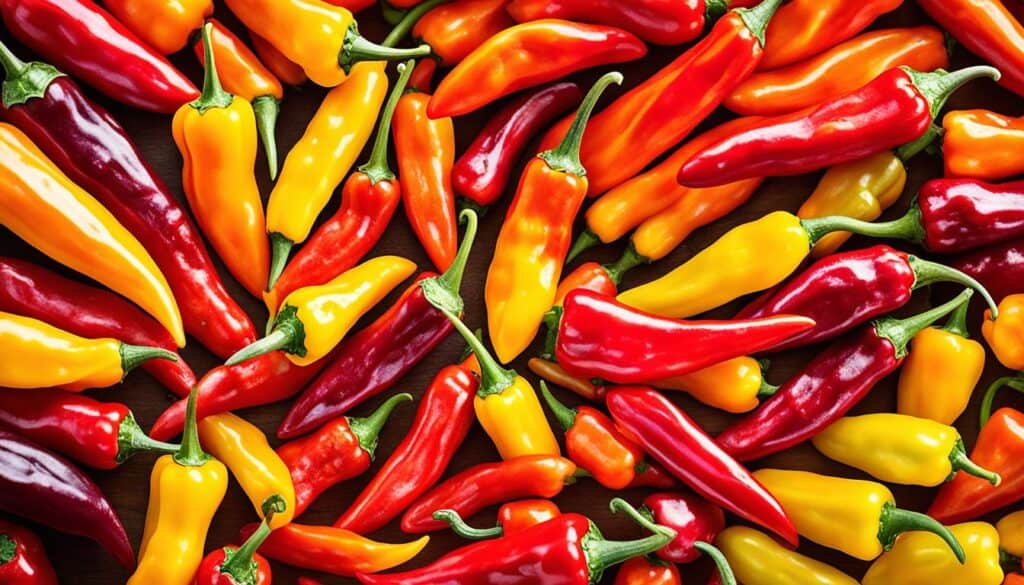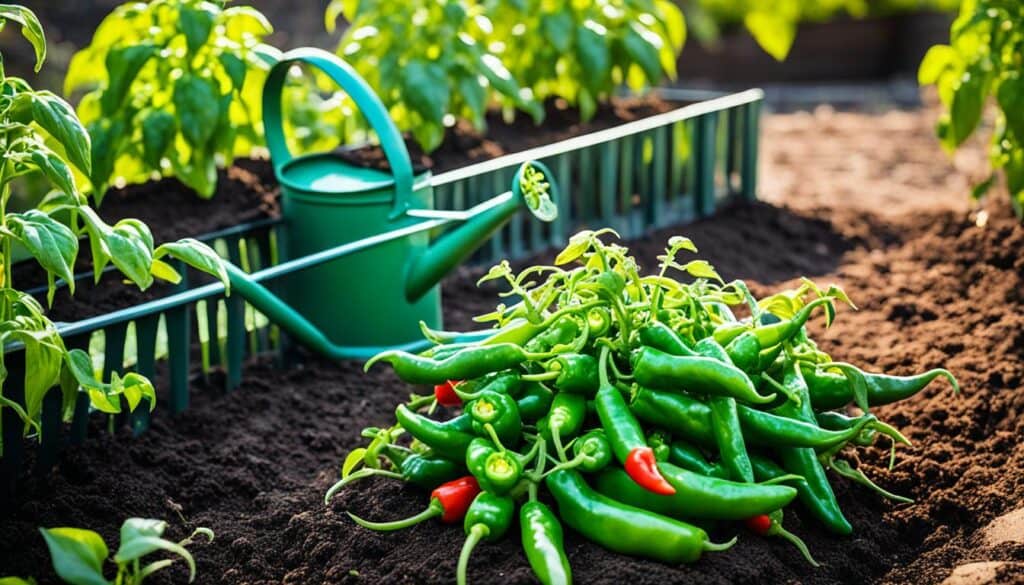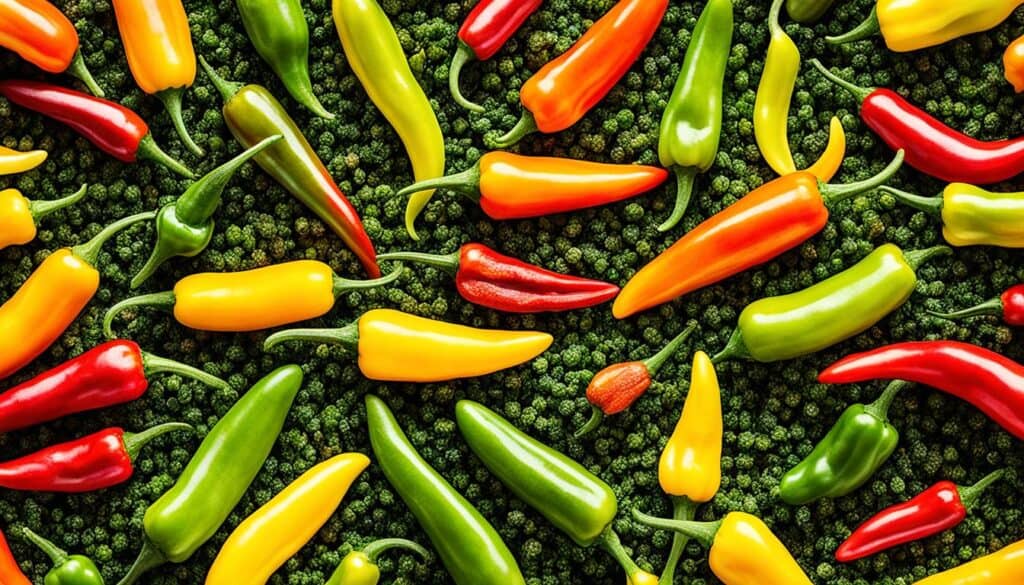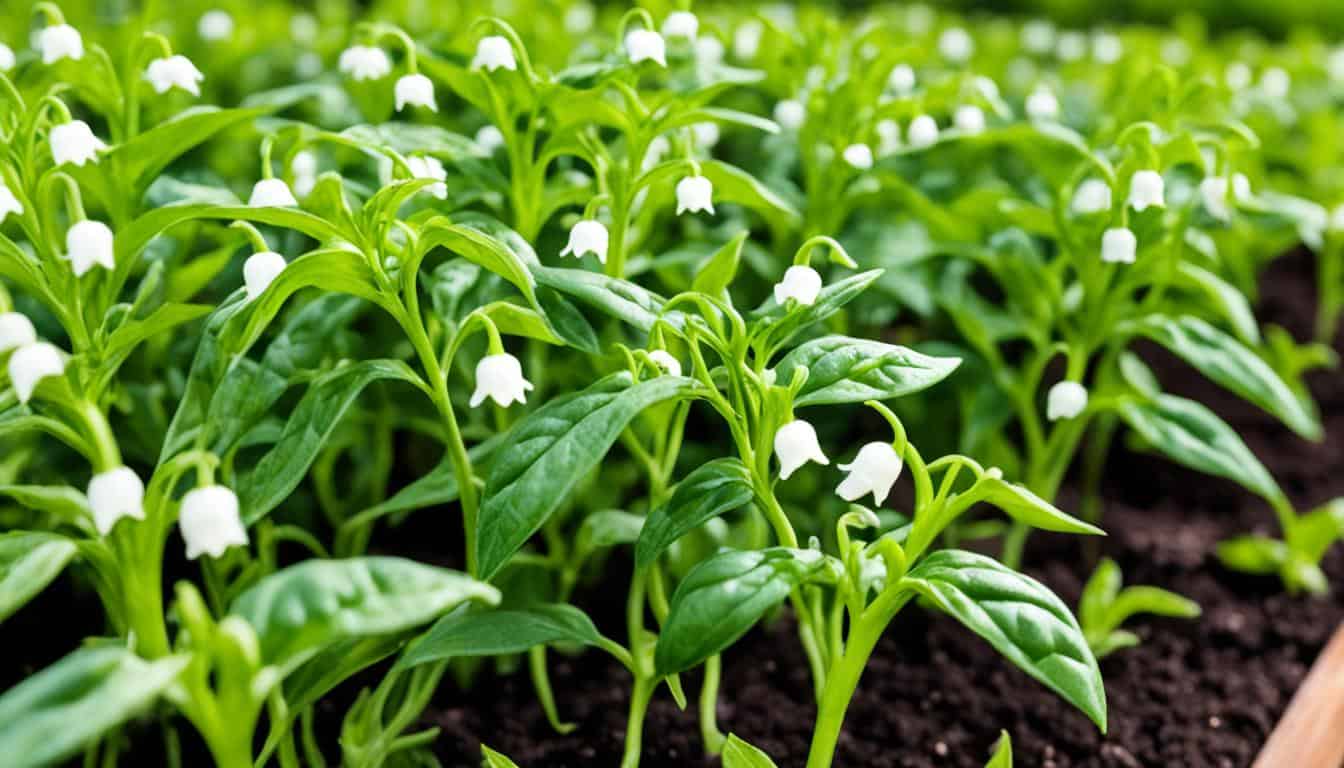Did you know that Hungarian Wax Pepper is not only a staple in Hungarian cuisine but also a favorite of spicy vegetable enthusiasts worldwide? With its vibrant yellow color and moderate to high heat level, this pepper variety packs a flavorful punch that will surely spice up your dishes. Whether you’re a seasoned pepper enthusiast or a beginner gardener, this comprehensive guide will provide you with all the information you need to know about growing, cooking, and enjoying Hungarian Wax Pepper.
Key Takeaways:
- Explore the world of Hungarian Wax Pepper, a versatile and spicy vegetable.
- Discover the Scoville scale and understand heat levels.
- Learn tips and techniques for growing Hungarian Wax Pepper in your vegetable garden.
- Unlock delicious recipes and ideas for cooking with Hungarian Wax Pepper in your kitchen.
- Discover the potential health benefits of Hungarian Wax Pepper.
The Scoville Scale: Understanding Heat Levels
The Scoville scale is a measurement of the pungency or spicy heat of chili peppers. It is named after its creator, pharmacist Wilbur Scoville. The scale is based on the amount of capsaicin, a chemical compound that stimulates chemoreceptor nerve endings in the skin, present in the pepper.
Hungarian Wax Pepper falls within the range of 5,000 to 15,000 Scoville Heat Units (SHU), indicating its moderate to high heat level.
Understanding the Scoville Heat Units
To appreciate the heat level of chili peppers, it is important to understand the Scoville Heat Units (SHU). The Scoville scale assigns a numerical value to peppers based on the concentration of capsaicin, which is responsible for the pepper’s spiciness. The higher the SHU, the hotter the pepper.
| Heat Level | Scoville Heat Units (SHU) |
|---|---|
| Mild | 0 – 1,000 |
| Medium | 1,000 – 10,000 |
| Hot | 10,000 – 100,000 |
| Very Hot | 100,000 – 350,000 |
| Extreme | 350,000+ |
As Hungarian Wax Pepper falls within the range of 5,000 to 15,000 SHU, it should be considered moderately to highly spicy. This makes it a great choice for those who enjoy a bit of heat in their dishes.
“The Scoville scale allows us to understand the heat levels of chili peppers and make informed decisions when cooking or enjoying spicy food.”
Knowing the Scoville Heat Units can help you determine the right pepper for your heat preference. Whether you’re a fan of mild peppers or enjoy the fiery heat of extremely spicy varieties, the Scoville scale provides a helpful guide for navigating the world of chili peppers.
Growing Hungarian Wax Pepper: Tips and Techniques
If you’re looking to add some spice to your vegetable garden, growing Hungarian Wax Pepper is a fantastic choice. This versatile pepper, known for its vibrant yellow color and moderate to high heat, is a delightful addition to any garden. With the right tips and techniques, you can successfully cultivate Hungarian Wax Pepper in your own backyard.
Choosing the Right Location and Soil
Hungarian Wax Pepper thrives in warm climates and requires full sun to ensure optimal growth and fruit production. When selecting a location for your pepper plants, choose an area that receives at least 6-8 hours of direct sunlight each day. This will provide the peppers with the warmth they need to grow and ripen.
In terms of soil, Hungarian Wax Pepper prefers well-draining soil that is rich in organic matter. Prepare your garden bed by incorporating compost or well-rotted manure into the soil to improve its fertility. This will help provide the necessary nutrients for healthy plant development.
Planting and Spacing
You have two options when it comes to starting Hungarian Wax Pepper from seeds or transplants. If you choose to start from seeds, plant them indoors 8-10 weeks before the last frost date in your area. Sow the seeds in seed trays or small pots filled with seed-starting mix, keeping the soil consistently moist until the seeds germinate.
Once the seedlings have grown to a height of around 3-4 inches and all risk of frost has passed, it’s time to transplant them into your garden. Dig holes that are slightly larger than the root ball of each seedling, and be sure to space them at least 18-24 inches apart. This will give the plants enough room to grow, allowing for proper air circulation and preventing the spread of diseases.
Caring for Your Pepper Plants
Regular watering is essential for the healthy development of Hungarian Wax Pepper plants. Aim to keep the soil consistently moist, but not waterlogged. Overwatering can lead to root rot and other problems, so be sure to allow the soil to dry out slightly between waterings. Applying a layer of mulch around the base of the plants can help retain moisture and suppress weed growth.
In terms of fertilization, Hungarian Wax Pepper benefits from regular feeding with a balanced fertilizer. Apply a slow-release fertilizer when planting and supplement with additional applications throughout the growing season as directed by the product label.
Pest control is an important aspect of pepper plant care. Keep an eye out for common pests such as aphids, whiteflies, and pepper maggots. If an infestation occurs, consider using organic pest control methods or insecticidal soap to manage the problem effectively.
Harvesting and Storing
As Hungarian Wax Pepper matures, its color will change from green to vibrant yellow. When the peppers reach their desired size and color, carefully cut them from the plant using a sharp pair of scissors or pruning shears. Leaving a short stem attached to the pepper can help prolong its shelf life.
To store Hungarian Wax Pepper, keep them in a cool, dry place such as a pantry or refrigerator. If properly stored, the peppers can last for up to two weeks. Alternatively, you can preserve the peppers by pickling or freezing them for later use.
Remember: Always wear gloves when handling hot peppers to protect your skin from potential irritation caused by the capsaicin compound present in the peppers.
| Key Tips for Growing Hungarian Wax Pepper |
|---|
| Choose a sunny location and well-draining soil. |
| Start seeds indoors or transplant seedlings after the last frost. |
| Provide adequate spacing between plants for proper growth. |
| Water regularly, keeping the soil consistently moist. |
| Fertilize with a balanced fertilizer throughout the growing season. |
| Monitor for pests and manage infestations as necessary. |
| Harvest peppers when fully ripe and store in a cool, dry place. |
Cooking with Hungarian Wax Pepper: Recipes and Ideas
Hungarian Wax Pepper is a versatile ingredient in the kitchen. Its vibrant color and moderate heat make it suitable for a variety of recipes. Whether you’re a fan of spicy dishes or prefer a milder kick, this pepper can add a unique flavor profile to your meals. Here are some delicious recipes and ideas to inspire your culinary adventures with Hungarian Wax Pepper:
Fresh and Crunchy Hungarian Wax Pepper Salad
Ingredients:
- 2 Hungarian Wax Peppers, thinly sliced
- 1 cucumber, thinly sliced
- 1 red onion, thinly sliced
- 1/4 cup fresh parsley, chopped
- 2 tablespoons lemon juice
- 2 tablespoons extra virgin olive oil
- Salt and pepper to taste
Instructions:
- In a large bowl, combine the sliced Hungarian Wax Peppers, cucumber, red onion, and parsley.
- In a separate small bowl, whisk together the lemon juice, olive oil, salt, and pepper.
- Pour the dressing over the pepper mixture and toss until well coated.
- Refrigerate for at least 30 minutes to allow the flavors to blend.
- Serve chilled and enjoy!
Pickled Hungarian Wax Peppers
Ingredients:
- 1 pound Hungarian Wax Peppers
- 1 cup water
- 1 cup white vinegar
- 2 tablespoons sugar
- 2 cloves garlic, smashed
- 1 teaspoon salt
- 1/2 teaspoon black peppercorns
Instructions:
- Wash and dry the Hungarian Wax Peppers. Slice them into rings or leave them whole, depending on your preference.
- In a saucepan, combine the water, vinegar, sugar, garlic, salt, and black peppercorns. Bring to a boil over medium heat and stir until the sugar and salt have dissolved.
- Remove the pan from the heat and let the pickling liquid cool for a few minutes.
- Place the pepper slices or whole peppers in a clean jar or several smaller jars.
- Pour the cooled pickling liquid over the peppers, making sure they are fully submerged.
- Seal the jar(s) and refrigerate for at least 24 hours before enjoying the pickled peppers.
Roasted Hungarian Wax Pepper Stuffed with Cheese
Ingredients:
- 4 Hungarian Wax Peppers
- 1 cup shredded mozzarella cheese
- 1/4 cup grated Parmesan cheese
- 1/2 cup breadcrumbs
- 2 tablespoons olive oil
- 1/2 teaspoon dried oregano
- 1/4 teaspoon garlic powder
- Salt and pepper to taste
Instructions:
- Preheat your oven to 400°F (200°C).
- Cut a slit lengthwise down each Hungarian Wax Pepper, being careful not to cut all the way through. Remove the seeds and membranes.
- In a mixing bowl, combine the mozzarella cheese, Parmesan cheese, breadcrumbs, olive oil, dried oregano, garlic powder, salt, and pepper.
- Stuff each pepper with the cheese mixture, pressing gently to fill the cavity evenly.
- Place the stuffed peppers on a baking sheet lined with parchment paper.
- Bake for 15-20 minutes, or until the peppers are tender and the cheese is melted and golden brown.
- Remove from the oven and let cool for a few minutes before serving.
“The unique flavor and moderate heat of Hungarian Wax Pepper can elevate any dish, from salads to mains. Get creative and experiment with different cooking methods to fully enjoy the versatility of this incredible pepper.”
As you can see, Hungarian Wax Pepper can add a delightful twist to your meals. Whether you’re enjoying it fresh in a salad, pickled for added tanginess, or roasted for a smoky flavor, this versatile pepper is sure to impress your taste buds. Don’t be afraid to explore the rich culinary heritage of Hungarian cuisine and experiment with new recipes that incorporate the unique characteristics of Hungarian Wax Pepper.
Now that you have some recipe ideas in mind, let’s move on to explore the health benefits of Hungarian Wax Pepper.
Health Benefits of Hungarian Wax Pepper

Hungarian Wax Pepper, like other chili peppers, contains capsaicin, which has been associated with a variety of potential health benefits. Capsaicin, the compound responsible for the spice in chili peppers, has been shown to:
- Aid digestion
- Boost metabolism
- Provide pain relief
- Have antioxidant and anti-inflammatory properties
It’s important to note that while Hungarian Wax Pepper may offer these health benefits, consulting with a healthcare professional is crucial before using it for medical purposes.
| Health Benefits | Capsaicin | Source |
|---|---|---|
| Aids digestion | ✓ | source |
| Boosts metabolism | ✓ | source |
| Provides pain relief | ✓ | source |
| Has antioxidant and anti-inflammatory properties | ✓ | source |
Other Pepper Varieties: Exploring Different Heat Levels

While Hungarian Wax Pepper falls within the moderate to high heat range, there are many other pepper varieties with varying heat levels. From the mild sweetness of bell peppers to the insane spiciness of Carolina Reaper, the world of peppers offers a wide range of flavors and intensities. Some popular hot pepper varieties include Jalapeno, Habanero, and Ghost Pepper. Experiment with different pepper varieties to find your preferred level of heat.
Pepper Cultivation Tips: Maximizing Flavor and Heat

To maximize the flavor and heat of pepper varieties, including Hungarian Wax Pepper, there are a few cultivation tips that I’ve found useful. Here are some key considerations to keep in mind when growing peppers:
- Provide Adequate Sunlight: Peppers thrive in full sun, so make sure to choose a sunny spot in your garden or use grow lights if you’re growing them indoors.
- Water Regularly: Peppers require consistent moisture, so water them regularly, especially during dry spells. However, be careful not to overwater, as it may lead to root rot.
- Fertilize Appropriately: Use a balanced fertilizer or organic compost to provide the necessary nutrients for healthy pepper growth. Follow the instructions on the product label for the best results.
- Control Weeds: Keep the area around your pepper plants free of weeds to prevent competition for nutrients and water.
- Prune for Air Circulation: Proper air circulation is important for preventing moisture-related diseases. Prune any overcrowded branches or leaves to promote airflow within the plant.
While these general tips apply to most pepper varieties, some gardeners believe that stressing the plants can enhance the intensity of the peppers’ heat. They recommend withholding water or exposing the plants to cooler temperatures at specific times during their growth. However, it’s crucial to find a balance because over-stressing the plants can hinder their overall growth and productivity.
Experimenting with different cultivation techniques can be an exciting part of growing peppers. Remember, each gardener has their own methods, so adapting these tips to suit your garden’s specific conditions and your personal preferences is always a good idea. Now, let’s dive into some flavorful and spicy pepper recipes in the next section!
Spicy Vegetable Garden: Creating a Pepper Paradise

If you’re a fan of spicy vegetables like Hungarian Wax Pepper, why not consider creating a dedicated spicy vegetable garden? It’s a fantastic way to have a steady supply of these flavorful peppers right at your fingertips.
First, select a location for your garden that receives ample sunlight. Hungarian Wax Peppers, like many other vegetables, thrive in full sun. Ensure that the soil in your chosen spot is well-draining to prevent waterlogged roots.
Careful planning is key when designing your garden layout. Give each pepper variety its own space to grow, ensuring that there is enough room for the plants to spread out. This will promote healthy growth and airflow, reducing the risk of diseases.
To create a harmonious garden ecosystem, consider incorporating companion plants. Herbs like basil and oregano not only complement the flavors of spicy vegetables but also deter common pests. Flowers such as marigolds and nasturtiums attract beneficial insects like ladybugs and bees, which can help pollinate the pepper plants.
“Creating a dedicated spicy vegetable garden allows you to indulge in a variety of fiery flavors and experiment with new recipes!”
Once your garden is set up, it’s important to regularly monitor and maintain it to ensure the health and productivity of your pepper plants. Keep an eye out for signs of pests or diseases and take appropriate action. Maintain a consistent watering schedule, as peppers prefer slightly moist soil. Applying organic fertilizers can also help promote growth and enhance the flavor of your peppers.
By creating your spicy vegetable garden, you’ll not only have a bountiful supply of Hungarian Wax Pepper but also the opportunity to explore other spicy vegetables like jalapenos, cayenne, or serrano peppers, adding even more excitement to your culinary adventures.
Spicy Vegetable Garden Tips:
- Choose a sunny location with well-draining soil.
- Plan the layout carefully, giving each pepper variety sufficient space.
- Incorporate companion plants like herbs and flowers to deter pests and attract beneficial insects.
- Regularly monitor your garden for pests and diseases.
- Maintain a consistent watering schedule and apply organic fertilizers.
Ready to embark on this flavorful journey? Let’s dive into the world of spicy vegetables and create your own pepper paradise!
| Spicy Vegetables | Heat Level (Scoville Heat Units) |
|---|---|
| Hungarian Wax Pepper | 5,000-15,000 SHU |
| Jalapeno Pepper | 2,500-8,000 SHU |
| Cayenne Pepper | 30,000-50,000 SHU |
| Ghost Pepper | 855,000-1,041,427 SHU |
Conclusion
Hungarian Wax Pepper is a fantastic addition to any garden and kitchen. Its moderate to high heat adds a unique flavor profile to dishes, while its vibrant yellow color makes it visually appealing. Whether you’re growing Hungarian Wax Pepper in your vegetable garden or using it in your recipes, the possibilities are endless.
Spice up your dishes and explore the world of chili peppers. Hungarian Wax Pepper is just one of the many varieties available, each with its own distinctive flavor and heat level. From the mild sweetness of bell peppers to the fiery intensity of Carolina Reaper, there’s a pepper to suit every taste.
As you experiment with different chili peppers, you’ll discover their individual characteristics and culinary uses. Some peppers are ideal for adding a kick to salsas and stir-fries, while others lend themselves perfectly to marinades and hot sauces. The choice is yours! So go ahead, embrace the heat, and elevate your favorite recipes with the flavorful heat of Hungarian Wax Pepper and other chili pepper varieties.





Leave a Reply